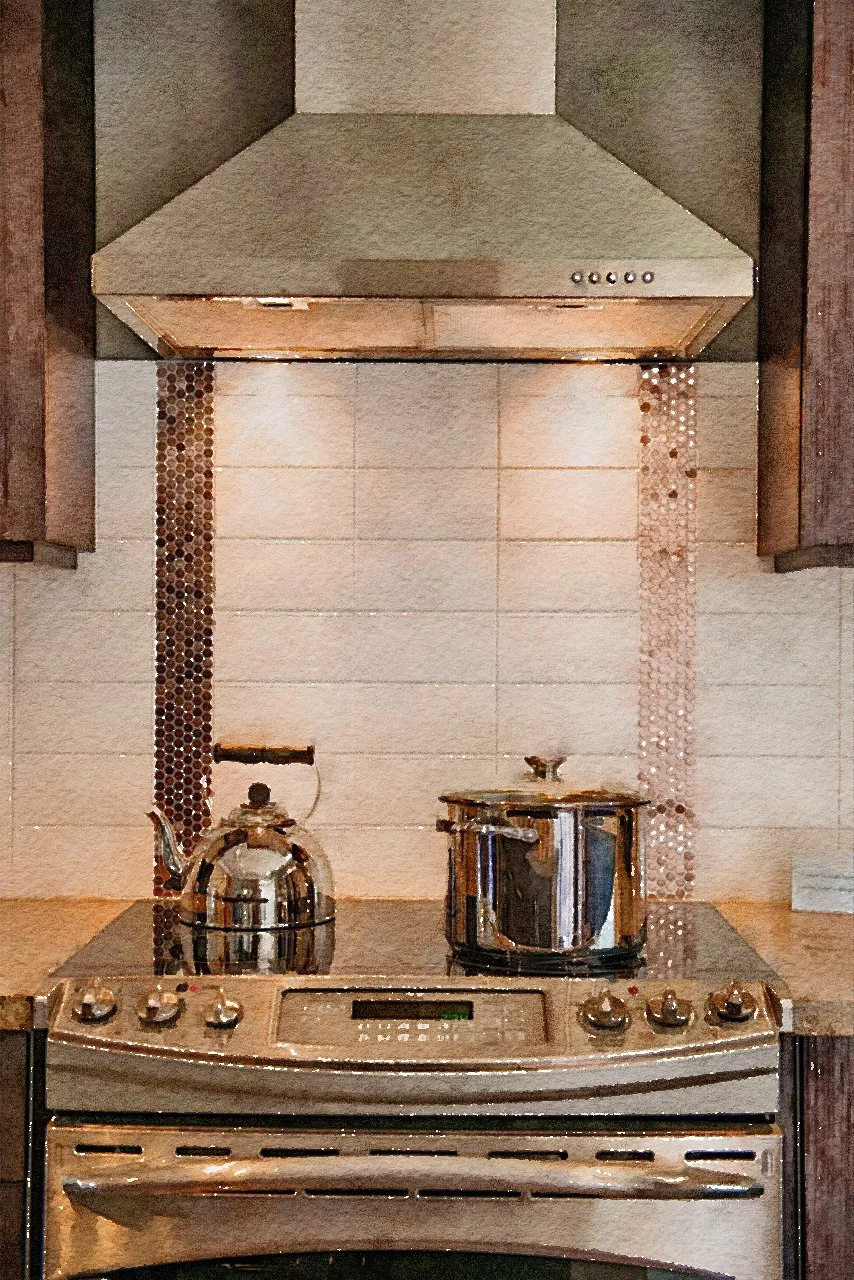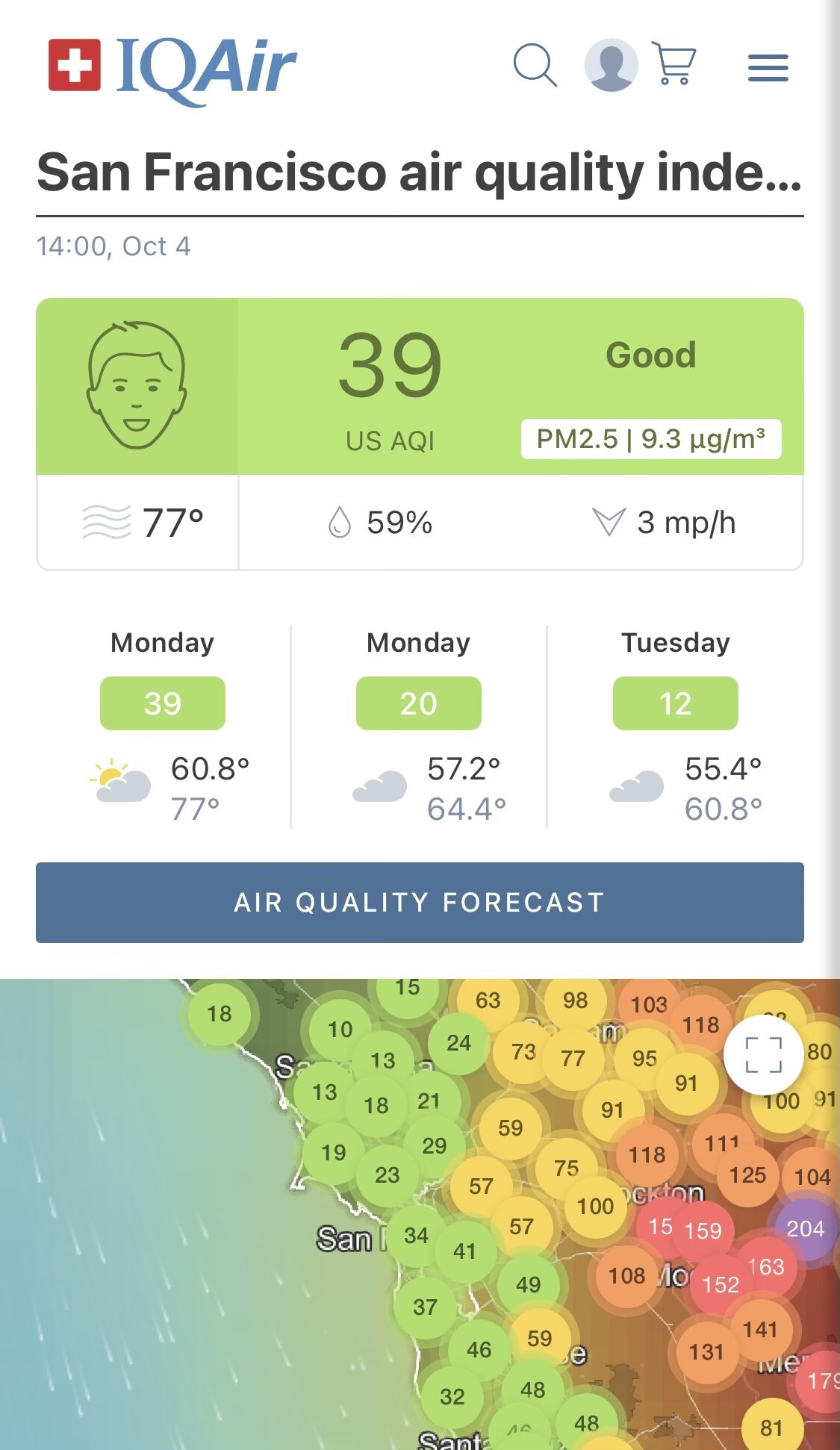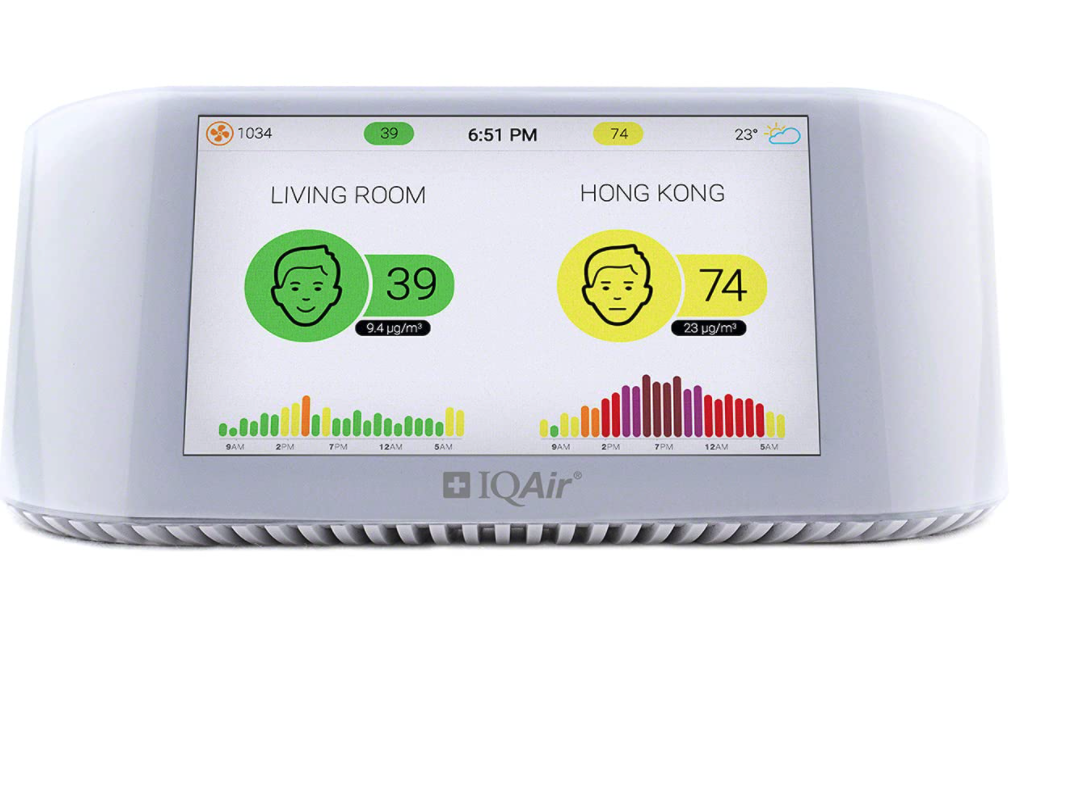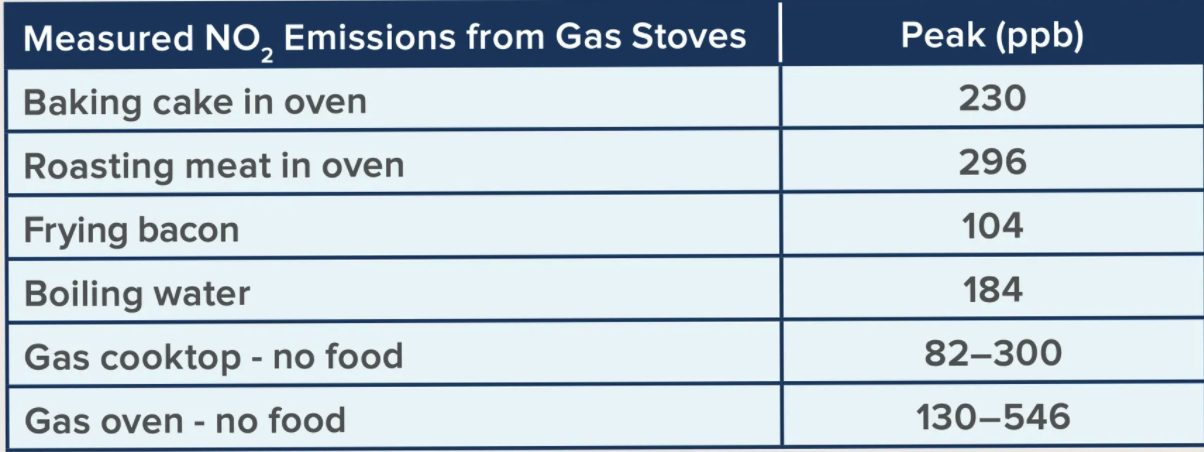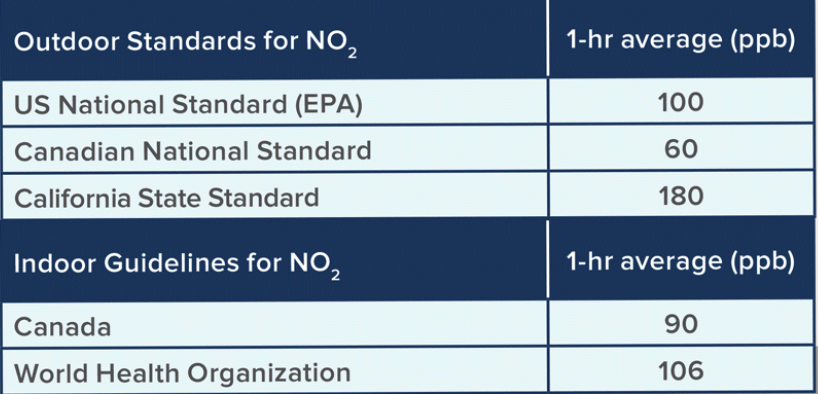Safety Topic: Air Pollution from Cooking
We have been paying particularly close attention to air quality this summer because of the horrible wild fires on the west coast, especially since babies are more susceptible to long term health damage from smoke and chemicals.
What we did not expect was how polluted we make our home everyday just by cooking.
If electricity is produced by fossil fuels, the pollution happens at a power plant. When cooking w/ gas, that combustion is occurring right in your kitchen. Test it out by testing in your own kitchen!
Key findings:
1/3 of Americans use natural gas for cooking, but this emits potentially harmful pollutants into your home.
Within 12 minutes, with one burner to heat water, and oven set to 375, NO2 levels reached 60% higher than guidelines from the World Health Org (WHO). This is at a level where studies show people start to have changes in lungs to worsen disease or cause problems.
Research shows children growing up in homes with natural gas stoves have 20% increased risk of developing asthma
Gas stoves can release 2x+ more harmful tiny particles (and chemicals) than electric stoves
Vents and filters CAN clean the air, however we have to USE them, and their efficiencies vary from 15-98%. Try opening windows when cooking whenever possible, and make sure, if you have a vent, it pushes dirty air to the outside (recirculation does no good).
There are no gas standards for INDOOR air pollution in the US. And most stoves only measure safe levels of CO2, but ignore equally harmful NO2 gases.
Mild increases in air pollution levels over 10 years caused the same type of lung damage seen after almost 30 years of smoking a pack of cigarettes a day.
An indoor air monitor can keep you mindful of your own daily exposure
Indoor and outdoor fireplaces can also be harmful to our health.
Counties with more air pollution see higher Covid-19 fatality rates
My own home measurements
I set up a mobile pollution monitor in my own home to measure air quality from wild fires in California. But what i niticed was a major spike when cooking!
During the hour of cooking with a gas stove, NO2 concentrations spiked close to 200 ppb.
Readings average 140 to 150 ppb over the course of the hour cooking
Another day, I accidentally burnt something in the oven, and the air quality was over 400 ppb (with the little purple toxic gas logo flashing).
These all exceeds of the US outdoor NO2 standard of 100 ppb for one-hour exposure.
Acceptable limits
In response to early studies, Canada lowered its acceptable limits:
one-hour outdoor standard to 60 ppb.
indoor one-hour NO2 standard is 90 ppb
the World Health Organization recommends a limit of 106 ppb indoors
the EPA has no indoor pollution standards
The difference in smoke
The makeup of air pollution is very different and depends on where we live.
It can come in the form of
burning fuels, whether to cook food, or to make energy
car exhaust (diesel much more toxic than regular gas)
cigarette smoke
fire smoke (wild fires, indoor fire places, or outdoor fire pits)
Cigarette smokers breathe in over 7,000 chemicals, and at least 69 of these are known to cause cancer. But ambient air quality tends to be overlooked. Any kind of burning sends particles and hazardous gases into the air.
WebMD compared air pollution in various cities to smoking cigarettes.
While not suggesting that breathing in air pollution is actually the same as smoking a cigarette, it is an illustration of how unexpected sources of pollution can cause similar harm over time.
Air pollution carries many health risks associated with smoking -- from lung cancer and emphysema to heart disease and stroke. Like cigarettes, even small amounts are not safe. The more we inhale, the higher the risks.
Even modest increases in particle pollution raise the risk of some of the same respiratory problems and diseases.
“Living in an area with high pollution is more like living with people who smoke two to three packs a day.” But unlike cigarettes, air pollution usually doesn’t come with a warning label or a telltale odor.
Research shows that the health risks from cigarette smoking and air pollution are similar. A recent study found that breathing air with mild increases in air pollution levels over 10 years caused the same type of lung damage seen after 29 years of smoking a pack of cigarettes a day.
Various gases and their side effects
Even in the absence of any food, gas combustion produces PM2.5 (one of the deadliest air pollutants).
Research suggests gas cooking produces about twice as much PM2.5 as electric.
It also produces
nitrogen oxide (NO)
nitrogen dioxide (NO2)
carbon monoxide (CO)
formaldehyde (CH2O or HCHO)
All of these pollutants are health risks if not properly managed.
These chemicals, individually, have negative impacts on health. Exactly how they combine to affect health are not understood, but we do know many chemicals compound in their damage to be twice as toxic, or even 100x their toxicity when in combination.
More on these individual gases:
Nitrogen dioxide (NO2)
one of the most familiar and well-studied pollutants. EPA research shows that exposure to NO2 — even small increases in short-term exposure — exacerbates respiratory problems, particularly asthma, and particularly in children.
Exposure limits
the standard for long-term outdoor exposure is 53 ppb
but still effects seen at much lower exposures: every 5 ppb increase above 6 ppb led to a measurable increase in wheezing and asthma severity
EPA research also linked long-term NO2 exposure to
cardiovascular effects, diabetes, poorer birth outcomes, premature mortality, and cancer.
research has linked ongoing NO2 exposure to reduced cognitive performance, especially in children under 4
This 2009 study concluded that “early-life exposure to air pollution from indoor gas appliances may be negatively associated with neuropsychological development.”
Carbon monoxide (CO)
can exacerbate cardiovascular illness among people with coronary heart disease
Average CO levels
In homes without gas stoves: are between 0.5 and 5 ppm
Homes with gas stoves, properly adjusted: are btwn 5 and 15 ppm
Poorly adjusted stoves can be 2x as high: 30 ppm+
Virtually all gas utilities have policiesevaluating acceptable CO emissions levels from residential gas equipment (but not NO2). “What you measure, you manage.”
In general, newer cooktop burners don’t produce much carbon monoxide because of design improvements.
Formaldehyde (CH2O or HCHO).
the same stuff used to preserve dead bodies
interferes with mylenin (protein that coats nerve cells). mylenation allows information to flow though our nervous system.
can cause cancer or provoke immune system rise to immune disorders
Various forms of Pollution from Cooking
Various stove types can release pollutants into the air (including, but not limited to: carbon monoxide and formaldehyde), resulting in high levels of indoor air pollution
Natural gas and propane stoves release harmful gases
Wood stoves or fireplaces create pollution from wood smoke
Cooking itself can generate unhealthy air pollutants from heating oil and fat, especially at high temperatures
Self-cleaning ovens, whether gas or electric, can create high levels of pollutants as food waste is burned away
Non stick pans release toxins, especially when the coating is broken
Cooking of any kind produces pollutants that are harmful if not properly handled.
Applying heat to food produces tiny particles that can add up to health problems
tiny particles (PM10, or particulate matter 10 micrometers in diameter),
tinier particles (PM2.5, or 2.5 micrometers in diameter),
and even tinier “ultrafine” particles (100 nanometers in diameter)
But cooking through direct combustion of fuel produces more pollutants than electric cooking.
This is especially true when cooking with wood or charcoal, which is common in the developing world (one reason millions of Indian women suffer respiratory problems)
And even true with gas, the “clean” combustion fuel.
Health problems from smoke
Most common
nose and throat irritation
headaches
fatigue
nausea
Susceptible groups:
Young children
pets
people with asthma
people with heart or lung disease
Gas produces ultrafine particles, smaller than 100 nanometers, which are dangerous because they can move around your body in ways that larger particles can’t.
Canary in the coal mine
Gases can be particularly toxic to babies and pets, whose systems are just more delicate than adults. Just like the famous analogy, coal miners would bring caged birds with them into the mines since they pass out faster at toxic gas levels.
Babies and pets should be kept away from burning fuels when possible, including indoor and outdoor firepits as well.
Children in homes with gas stoves have
42% increased risk of experiencing asthma symptoms over their lifetime
24% increased risk of being diagnosed with asthma by a doctor
Lower-income households are more likely to have more people living in smaller spaces, with less ventilation
and a practice discovered to using gas stoves as a source of heat to supplement weak or broken furnaces.
Lower-income children already suffer asthma at higher rates than the national average, mainly because they are more likely to live near sources of outdoor air pollution (like roads and industrial facilities), which makes them more vulnerable to sources of indoor air pollution
Regulations
Clean Air act targets outdoor air quality (which has helped clean outdoor air quality by 74% since 1970)
However, there are no regulations about INDOOR air quality.
The Environmental Protection Agency (EPA) warns that
“studies of human exposure to air pollutants indicate that indoor levels of pollutants may be 2-5 times — and occasionally more than 100 times — higher than outdoor levels.”
homes with gas stoves have higher levels of NO2 than homes with electric stoves, around 50% to 400% and up, often exceeding US outdoor pollution standards.
One major source of indoor air pollution is the familiar gas stove
New literature review, after 20 years of studies, found that “gas stoves may be exposing tens of millions of people to levels of air pollution in their homes that would be illegal outdoors under national air quality standards.”
A 1986 report from its Clean Air Advisory Committee (34 years ago) urged the CPSC (consumer products safety) to do a better job of assessing the dangers — particularly related to NO2 — of indoor air pollution sources like gas stoves.
Ways to clean the air while cooking:
if your nose warns you something is up, you should open a window
Whenever cooking, open doors/windows for a cross breeze
Ventilation can help, but it isn’t enough
Stoves are not required to be vented outdoors
(while gas furnaces, dryers, and water heaters ARE required to connect outside).
many existing hoods and fans simply recirculate the air (and pollutants) rather than venting it outside.
If you have a range hood that just recirculates air back into the kitchen, you need to use another exhaust fan — for example, from a nearby bathroom — or open windows.
Performance of hoods varies widely, capturing 15 to 98 percent of emissions, depending on positioning and air flow.
people who do have them often don’t use them — they find them noisy or distracting, or just forget
turn on the vent/range hood (although many are inadequate, especially if renting)
Check to make sure it vents to the outdoors (island vents tend to be weaker than ones hooked up to the wall)
Use it while cooking or using your stove
Cook on the back burners, if possible, because the range hood exhausts this area more effectively.
If you don't have a range hood:
Use a wall or ceiling exhaust fan while cooking.
Open windows and/or exterior doors to improve air flow through the kitchen.
try not to leave oil burning for too long
replace non-stick pans with stainless steel (ESPECIALLY if the coating is scratched)
avoid use of indoor firepits (especially over night)
try to make sure bedroom windows do not blow in air from outdoor firepits
Use an air quality monitor
Use a filter in your kitchen
air purifiers with high-efficiency particulate air (HEPA) and carbon filters
Some plants have been used by NASA to clean indoor air quality
Frying, broiling and other cooking at high temperatures generally produces more pollutants. Try to cook food at lower temperatures, with less oils, and with oils that have higher smoke points.
Oils with higher smoke points include: avocado, coconut or olive oil
Canola oil has an extremely low smoke point, and becomes rancid after very little heat, causing other health problems like diabetes and heart disease, as associated with fried foods. But is very cheap, and the go-to option in restaurants and take-out.
Resources
CA.Gov: Indoor Air pollution from cooking
Stanford Medicine: Advise for Indoor Air Quality
NPR: We need to talk about your gas stove
EPA

